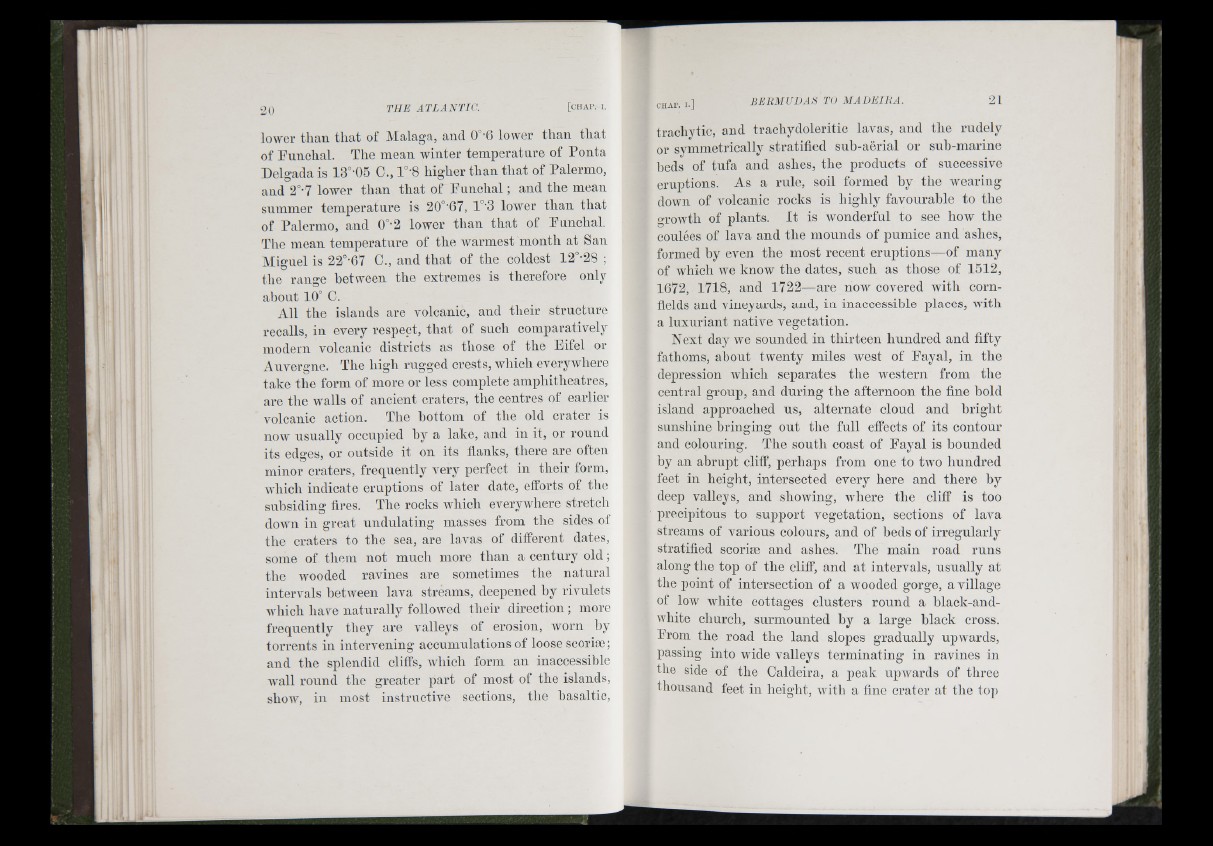
lower than that of Malaga, and 0°'6 loiver than that
of Funchal. The mean winter temperature of Ponta
Delgada is 13°-05 C., l°-8 higher than that of Palermo,
and 2°-7 lower than that of Funchal; and the mean
siunmer temperature is 20°‘67, 1°'3 loAver than that
of Palermo, and 0°-2 lower than that of Funchal.
The mean temperature of the warmest month at San
Miguel is 22°-67 0., and that of the coldest 12°-28 ;
the range between the extremes is therefore only
about 10° C.
All the islands are Amlcanic, and their structure
recalls, in every respect, th a t of such comparatively
modern volcanic districts as those of the Fifel or
Auvergne. The high rugged crests, which everywhere
take the form of more or less complete amphitheatres,
are the walls of ancient craters, the centres of earlier
volcanic action. The bottom of the old crater is
now usually occupied by a lake, and in it, or round
its edges, or outside it on its flanks, there are often
minor craters, frequently very perfect in their form,
Avhich indicate eruptions of later date, efforts of the
subsiding fires. The rocks Avhich everywhere stretch
down in great undulating masses from the sides of
the craters to the sea, are lavas of different dates,
some of them not mnch more th an a century o ld ;
the AAmoded ravines are sometimes the natural
intervals between lava streams, deepened by rivulets
Avhich have naturally folloAved their d irection; more
frequently they are valleys of erosion, Avorn hy
torrents in intervening accumulations of loose scorirn;
and the splendid cliffs, Avhich form an inacoessible
Avall round the greater p art of most of the islands,
shoAV, in most instructive sections, the basaltic,
trachytic, and trachydoleritic lavas, and the rudely
or symmetrically stratified sub-aerial or sub-marine
beds of tufa and ashes, the products of successive
eruptions. As a rule, soil formed by the wearing
doAvn of volcanic rocks is highly favourable to the
groAvth of plants. I t is AAmnderfnl to see how the
coulées of lava and the mounds of pumice and ashes,
formed by even the most recent eruptions—of many
of Avhich AA^e know the dates, such as those of 1512,
1672, 1718, and 1722—are now covered with cornfields
and vineyards, and, in inaccessible places, Avith
a luxuriant native vegetation.
Next day we sounded in thirteen hundred and fifty
fathoms, about twenty miles Avest of Fayal, in the
depression which separates the Avestern from the
central group, and during the afternoon the fine hold
island approached us, alternate cloud and bright
sunshine bringing out the full effects of its contour
and colouring. The south coast of Fayal is bounded
by an abrupt cliff, perhaps from one to tAvo hundred
feet in height, intersected every here and there by
deep valleys, and showing, AA’here the cliff is too
precipitous to support vegetation, sections of lava
streams of various colours, and of beds of irregularly
stratified scoriæ and ashes. The main road runs
along the top of the cliff, and at intervals, usually at
the point of intersection of a wooded gorge, a village
of loAV white cottages clusters round a hlack-and-
Avhite church, surmounted by a large black cross.
From the road the land slopes gradually upwards,
passing into wide valleys terminating in ravines in
the side of the Caldeira, a peak upAvards of three
thousand feet in height, Avith a fine crater at the top